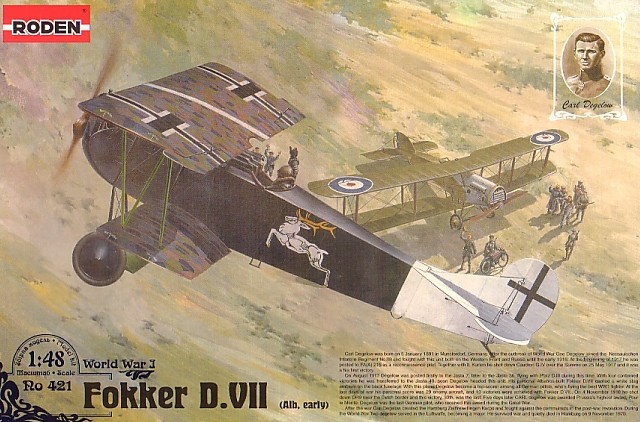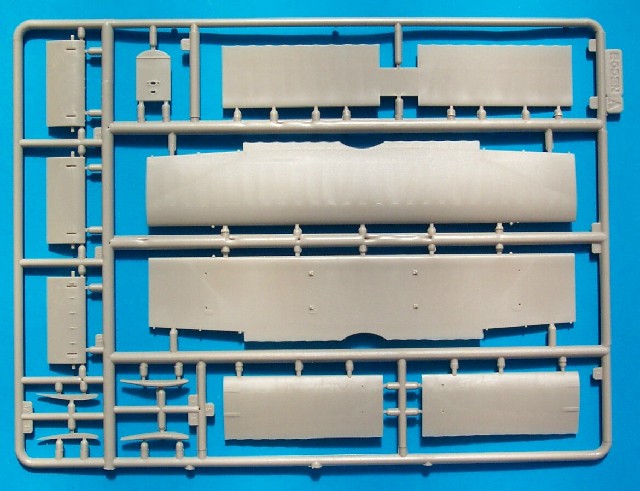|
Fokker D.VII
Albatros - early
built

Roden 1/48
S
u m m a r y
|
| Catalogue Number: |
Fokker D.VII (Albatros-early built)
Kit #421 |
| Scale: |
1/72 |
| Contents and Media: |
90 parts in injection moulded
plastic; markings for four aircraft |
| Price: |
USD$15.96 from Squadron.com
|
| Review Type: |
FirstLook |
| Advantages: |
Well-researched, accurate and superb
attention to detail. |
| Disadvantages: |
Some short moulding of lower wing
scallops. |
| Recommendation: |
Highly Recommended |
Reviewed by Robert Baumgartner

Roden's 1/48
scale Fokker D.VII Albatros early build is available online from Squadron.com
Roden’s release of the early Albatros-built version
to their existing range of the Fokker D.VII is a welcome one.
Licence variations were significant so this
latest offering provides the modeler with a sound basis to reproduce
these differences.
As expected the
majority of the sprues have been seen before, but to cater for this
option, Roden include a new “H” sprue. This contains a new radiator, top
engine covers, and side panels, all-important items to produce this
particular version.
The total of five sprues remains the same and these
have been moulded in the familiar soft grey plastic. Although there are
90 parts in all, the spare parts box will again profit as many of them
are used for other releases or options. Despite the number of sprues
that the moulds have produced so far, there is no deterioration in
quality. The detail on the parts remains sharp and clear with only a
minimum of flash.

Click on the thumbnails
below to view larger images:
Construction
starts with the engine and here Roden provide both Mercedes and BMW
engines. In this case the former is chosen and looks very nice when
assembled.
Be careful when installing it into the nose
section, as it is very easy to have the engine sitting too low.
To save in
tooling costs, the rear fuselage sections are in separate parts.
Fortunately, some prior test fitting will ensure that these sub
assemblies come together with a minimum of fuss.
The fuselage
halves are very nicely done with tubular frame detail moulded onto their
insides. A quite comprehensive cockpit is supplied. Along with the more
usual floor, seat, rudder bar, control column, Roden also provide the
pressure pump, compass and tachometer. Additional items are the fuel
tank (with gauge), forward cross member, rear “fabric” screen and
instrument panel. This latter item is in the “Fokker” layout so purists
may want to modify it to one more typical of Albatros.
Other items that can be incorporated into this area
are the auxiliary “throttle” lever and ignition control handle. Both of
these are located on the port side of the cockpit.
Don’t be put off by the shallow ejector pin marks
on the inner fuselage surfaces. These do not become obvious on the
completed model.
A couple of notches are present to ensure that the
lower wing locates securely into the fuselage. This is a tight fit and a
little trimming is needed to ensure that no anhedral is introduced.
Both wings come
as upper and lower halves with separate wingtips. Careful alignment will
allow for a snug fit but there is still the problem of the “short
moulded” lower wing. This has resulted in the loss of some of the
scalloping on the trailing edge and a little bit of putty to needed to
recreate these. While on the subject of the lower wing, don’t forget to
add the stacking pads.
The surface detail on the wings is very well done
with a subtle representation of both the ribs and plywood sheathing. The
separate ailerons are a welcome feature, as are the elevators and
rudder, and all feature slots to allow for the secure attachment of the
control horns.
One area of construction that may tax the builder
is the attachment of the upper wing.
The struts have to be perfectly positioned and
those that make the fully cowled version will need to thin the side
panel entry holes. This will help in positioning the struts at the
correct angle.
Interestingly
Roden suggest the use of part 11A for the “axle wing”. This is more akin
to OAW machines and part 9A is a better choice with the leading edge
hinges. Three different types of propeller are supplied as well as just
as many wheel covers. The ones with the rectangular covered valve holes
being the items usually worn by this version.
Four very striking options are provided:
a)Fokker D.V.II (Alb) flown by Ltn. August Hartmann, Jasta 30.
Hartmann’s personal
insignia of a “witch on a broomstick” was used on this Fokker D.VII. The
fuselage is believed to be brown with a yellow nose and tailplane, this
being described in a British intelligence report on the finish of Jasta
30 aircraft.
Hartmann didn’t score
any victories, the situation not being helped when he was wounded after
being with Jasta 30 for only a couple of weeks.
b) Fokker
D.V.II (Alb), Jasta 43, July 1918.
The red raven on this
aircraft suggests former ownership by Jasta 18. The upper surface of the
top wing appears to be a solid dark colour and given the machines
pedigree, it is assumed to be red in the style of Jasta 18. The two
white stripes also seen here are not supplied on the decal sheet but are
easy enough to apply with decal strip.
The fuselage is white,
broken up with some very eye catching red striping at the front end.
This latter decoration also needs to be sourced elsewhere.
c)
Fokker D.V.II (Alb) flown by Ltn. d R. Friedrich Jakobs, Jasta
43, mid 1918.
Jasta 43 aircraft
carried some very interesting markings and here is another one. It is
the crest and star marking of Jacobs and is flanked by white stripes on
a black fuselage. A photo of this machine suggests that there were at
least two bullet repair patches near the starboard fuselage cross.
It is obvious in a photo
that the cowling area is in a different grey tone to the rest of the
aircraft and it is suggested that this was finished in the factory
grey-green.
Jakobs only scored one
victory, this being a DH9 on the 22 July 1918. A couple of days later he
found himself wounded in action when he was shot through the foot.
d) Fokker
D.V.II (Alb) flown by Ltn. d R. Carl Degelow, Jasta 40.
Degelow spent some time
recovering from a wound at a sanatorium in Dresden. Here he saw the
establishment’s trademark of a leaping stag and decided to use it for
his own insignia. The silvery white artwork complimented the Jasta
colours very well, these being a black
fuselage and white tail.
It is thought that this
aircraft carried 5-colour lozenge so the purist will have to replace the
kits 4-colour sheets. Roden do supply the white stripe for the upper
wing.
Degalow went on to score
30 victories, 26 of them while with Jasta 40. As an airman he was the
last recipient of the Order Pour le Merite (Blue Max), this being on the
9 November 1918.
There are four sheets of decals that come with the
kit. Two are for the upper and lower 4-colour lozenge, one is for the
pink rib tapes and the other contains the national insignia, personal
markings and stencil data.

Click on the thumbnails
below to view larger images:
There were no register problems at all with these
sheets and this shows a commitment from Roden to improve their product
in this area. I couldn’t resist trying out one of the “crosses” to test
the usability of the items and was pleasantly surprised to find no
problems with the application or result.
Roden’s accurate series of Fokker D.VII aircraft
continues with this latest Licence-built
version. As usual, the kit stands up well to the best plans available
and this makes the modellers’ job a lot easier.
Some extra care will be needed during assembly so
take your time and your patience will be rewarded.
Highly Recommended
Thanks to
Squadron.com for the review
sample.
Review and Images Copyright © 2005 by
Robert Baumgartner
Page Created 01 February, 2005
Last updated 01 February, 2005
Back to HyperScale Main Page
Back to Reviews Page
|
Home | What's
New | Features
| Gallery |
Reviews | Reference
| Forum
| Search